Naturalist’s Notebook – June 11, 2016 to June 17, 2016
Three species of whale were seen feeding by the passengers of the Dolphin Fleet on June 11. Nancy Scaglione-Peck reports that there were probably more than thirty Minkes that would lunge every so often, creating a huge wave. She goes on to write that they also saw, “one giant finner” that “lunged and rolled pink and white belly up. We saw its entire ventral surface and beautiful white fluke.” Mark Gilmore adds that there were two humpbacks feeding on mackerel deep beneath the surface but they would sometimes be carried through the surface by the force of their lunges, allowing a view of their fully extended pleats. “Now, that’s a rorqual!” He further reports a sighting of a hundred or more Atlantic White-sided dolphins just outside Race Point. The large pod, with numerous mother and calf pairs, milled closely around the boat and several were seen leaping through the wake of the Dolphin X.
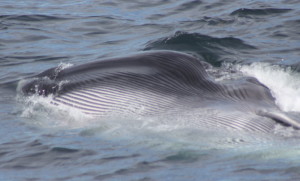
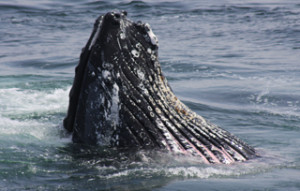
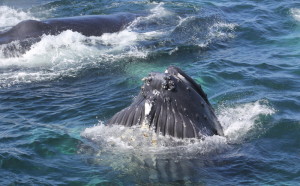
The first whale spotted by the Dolphin Fleet on June 12 was a Finback whale that was all over the place. It surfaced several times while the passengers and crew of the Dolphin X attempted to get clear views of it. It would rise to the surface, taking two or three breaths before arching higher up and dropping beneath the surface again. It never seemed to come up on the path it was following when it went down. Nor did it keep consistent dive times. But the captain, using whatever extra sense he posessed, put the vessel right beside the whale as it came up the last time. This time, it took three breaths and defecated. “You have to remember,” the naturalist said, “that whale poop is incredibly important to the mixing of essential nutrients in the marine environment.”
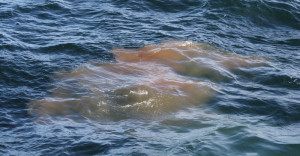
In the water, just like in the air, particles of nutrients fall to the bottom. Gravity works the same in both mediums. In the world of atmosphere, the plants that need the nutrients are at the bottom. Gravity works to pump the system. In the ocean, the plants are at the top. Gravity works against the system, making physical and biological pumps a necessity. As far as physical pumps go, upwellings are caused when two currents come together and when a current passes over a barrier like an incline of the sea floor. The steep sides of Stellwagen Bank are an excellent example of this. The currents hit the side and the cold, nutrient rich waters from the bottom are forced up along the face to the surface, bringing their nutrient loads and disolved oxygen with them for use. It is also true for more gentle slopes in shallow waters, though not as dramatically. And the rip currents at the Race serve to do the same thing, allowing the waters to mix vertically.
Some biological pumps serve to move the nutrients lower in the water by moving them up the food chain. What I like to call the poop pump does the opposite. When a whale defecates at the surface, the nutrients in its poop are delivered to the surface, where the plants that need them are. There was a time, before there were so many billions of us, that whale poop was the primary delivery system for nutrients to the phytoplankton of the ocean. With so many of us, nitrates and nitrites, phosphates and iron compounds run off the land and out of the rivers and sewers. The problem with this new system is that, along with the essential nutrients, runoff includes mercuries and cyanides and poisons that inhibit growth and cause decay. If the ocean is to recover, whale populations need to reclaim their role as fertilizers of the sea.
Japan, Iceland, Norway; If for no other reason, that is why we cannot keep killing them in bulk and making virtually no use of them. Realistically, because of the pollutants accumulated in the meat and blubber, you cannot safely eat whale meat. The peoples of Iceland and Norway don’t eat whalemeat. In Iceland, you can buy it as a tourist but the locals know it cannot be a staple of one’s diet. In Norway, they harvest whales largely to sell the meat to Japan, an endeavor of dubious international legality. But, in Japan, that whalemeat, and their own, is largely wasted while the government subsidizes the industry. Essentially, the government pays “scientists” to continue doing their junk science as an excuse to continue killing whales to very little purpose. Nothing new is learned. Nothing new is studied. And, while among some people, whale meat is thought of as a high priced delicacy, most of the whale meat shipped to Japan from Norway is simply disposed of. Japanese whalers, hunting whales in the Southern Ocean Whale Sanctuary, kill far more than that market requires.
I will step down off my soap-box now and apologize if I have offended anybody from one of those three countries who feels whaling is important. I am sure that there are cultural and historical ties to the industry, just like there are cultural and historical ties to various aspects of man’s inhumanity to man. When do we outgrow those ties? When do we no longer need them?
Finback whales like Rila, Breaker, and Pinch were the stars of June 13‘s whalewatches. Minke whales and Finback whales continued their assault on the vast schools of sand eels and herring. Even with the choppy and windy conditions, the underside of a lunging Minke whale’s fluke was seen by the passengers of the Dolphin VIII. One of the lunging Finners was consistantly rolling to reveal the tip of its left fluke above the surface. A lunging pair of Finback whales kept up feeding lunges that allowed the passengers to view the underside of the left flippers and fully swollen bellies. I have often remarked that the extended rorqual pleats of a Finwhale make it look like a giant tadpole. This was indeed the case today.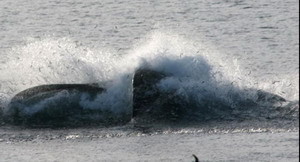
In the past several years, I have talked more than just a little bit about the use of bubbles by Humpback whales to scare and confuse schooling fish into a tighter ball. Sometimes, though not really frequently, a Finback will also blow a blast of bubbles immediately before lunging through a school of fish. When Humpbacks blow their bubbles, it is usually done at depth and the timing of their arrival at the surface is such that they arrive inside the cloud of bubbles. With Finners, the blast of bubbles usually occurs fairly close to the surface and before the animal dives beneath the school of fish. In other words, the bubbles blown by Finbacks are probably not being used to scare and confuse the schooling fish. John Conlon, who has been studying Finback whales for more than thrity years, both here and on the west coast, makes a compelling observation. He thinks that the blast of bubbles that precedes a Finwhale’s lunge may be nothing more than a heavy breath before a feat of strength and speed, much like we might exhale before lifting a heavy load. By expelling the air from its lungs, a Finner can actually make itself more streamline and, therefore, more likely to be successful in using speed to its advantage in getting as many small fish as it can in a mouthful.
Also, two Basking sharks were seen today by the passengers of the Dolphin X. Very close views were had from the starboard side of the vessel.
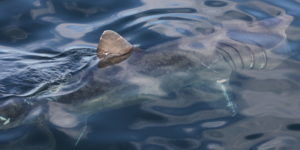
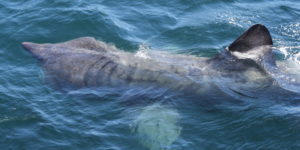
Islands of tinker mackerel. That’s what Liz Bradfield reported on June 14. Islands of tinker mackerel being fed upon by two Humpback whales and several Finback whales. “Gorgeous.”
On June 15, the sightings depended very much on where you went. That is always the way of it, but today it was more true than on other days. East of the Bank, there was a number of slow-moving Finback whales. One particular pair spent time moving alongside the Dolphin IX. Dennis Minsky observed, They “seemed to be almost logging, moving very slowly alongside the boat. We could see the entire length-and they were long!- and the beautiful and varied hues of the chevrons and blazes.”
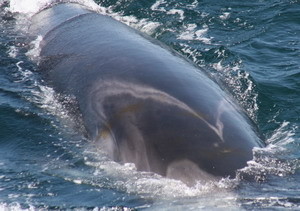
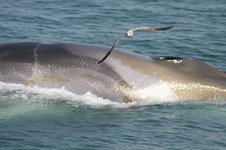
If, on the other hand, you went east, there was a group of a dozen or so Humpbacks feeding together through clouds of bubbles that they had blown before kicking the surface with their flukes. They appeared to be operating as a group, forming huge clouds and dragging through the glass-smooth sea. “Fantastic trip,” exclaims Dennis Minsky.
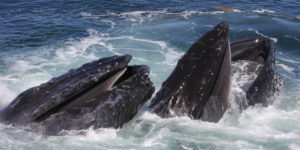
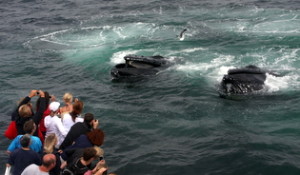
The Dolphin X chose to go south, along the backside to Wellfleet. Of the ten or so Humpback whales seen here, two were a mother and calf pair. They were taking advantage of the calm seas to have a little log. Whales, you will remember, cannot sleep like we do. If they just shut off their conscious minds, they would cease to breath and suffocate. Instead, they rest one hemisphere at a time. Humpback whales, due to their thick layer of blubber, can lie nearly motionless at the surface while they do this. This is called logging. The clear, blue skies and calm seas allowed passengers to see the entire body of both mother and calf. At one point, the calf rolled over, seeming to look at the boat, before dropping beneath its mother.
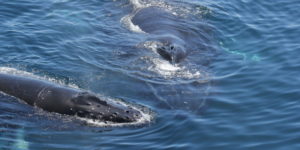
Amid the melee of kick-feeding Humpbacks on June 16 was a fairly good sized whale that, for one reason or another, chose to forgo the schooling fish in the waters around it and become curious about the Dolphin X. It spent quite some time going under the vessel, going up one side, then down the other, inspecting the stern and crossing the bow. This experience was repeated, whether or not from the same whale it is not known, for the passengers of the Dolphin IX.
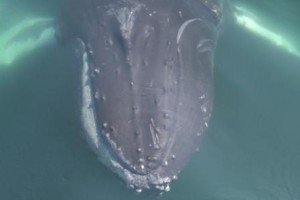
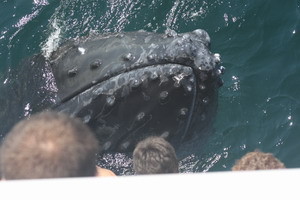
Among the feeding Humpback whales, there were a number of new mothers. While they blew their bubble clouds and bubble nets, and lifted tails high to slam down on the surface, their calves took to breaching and flipperslapping. At this point, though the moms have a lot of work to do to rebuild their blubber layers, the calves don’t really have that responsibility. They have the luxury of time. Time to build their muscles. Time to exercise. Time to interact. Time to play.
Not to downplay the feeding of the larger whales. Emily Sgarlat reports that, at one point, there were over twenty feeding Humpbacks around the boat and that many were seen dragging their undersides along the surface of the water to collapse their rorquals and expel the water from their mouths. Dennis Minsky says that his passengers were able to look down into the open mouths of numerous whales to see the sand eels struggle in their now futile attempt to get free.
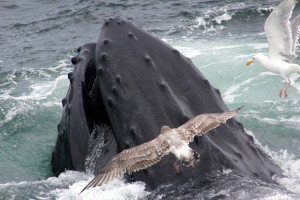
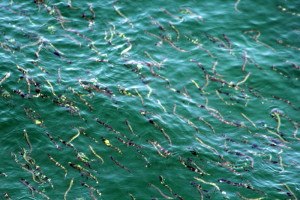
Everybody seemed to agree that the weather on June 17 was perfect for whalewatching. The sky was clear and blue, with bright sunshine, and the seas were flat and glassy calm. No mention of clouds was made by either naturalist today but, when they all use the term “perfect” in the picture they are painting for me, I always envision one or two puffy, cotton-ball clouds drifting by.
“Whales, whales, whales – as far as you could see.” That was Dennis Minsky from the Dolphin X. I have been working with Dennis on the Dolphin Fleet for more than twenty years. He is not a naturalist prone to exaggeration or poetic license. (That is my job.) That is why when he reports something like that, I just use his words. He goes on to say that most of the Humpback whales his passengers saw were actively engaged in making their living. Kick-feeding seemed to be the preferred method of corraling the forage fish, kick-feeding in combination with bubble clouds. He adds that there were also some bubble systems that appeared to be the result of cooperative feeding by multiple whales. He makes note that for the large number of feeding whales, between two dozen and three dozen, there were surprising few birds around. There were, however, schools of striped bass feeding on the sand eels. Tuna fishermen and scallopers were also present.
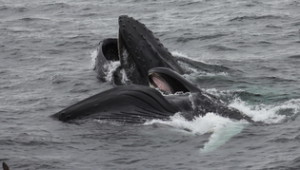
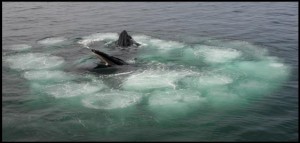
Liz Bradfield says that with all of the feeding Humpbacks, the wiggly and rolling calves, and the large pod of Atlantic White-sided dolphins, “It was hard to say what the highlight was.” Toward the end of the day, she reports that one of the calves was rolling over and flipper-slapping along the boat.





